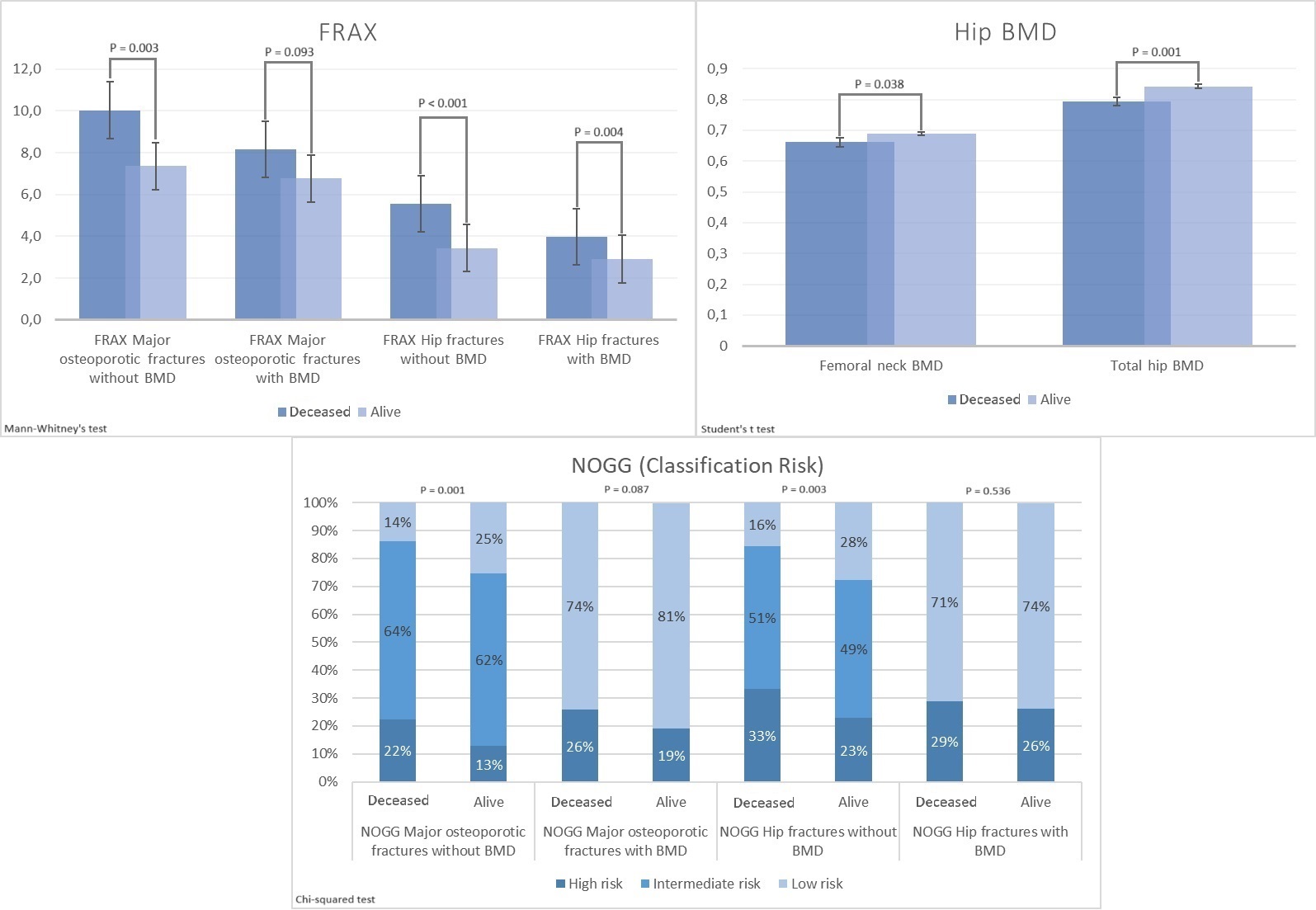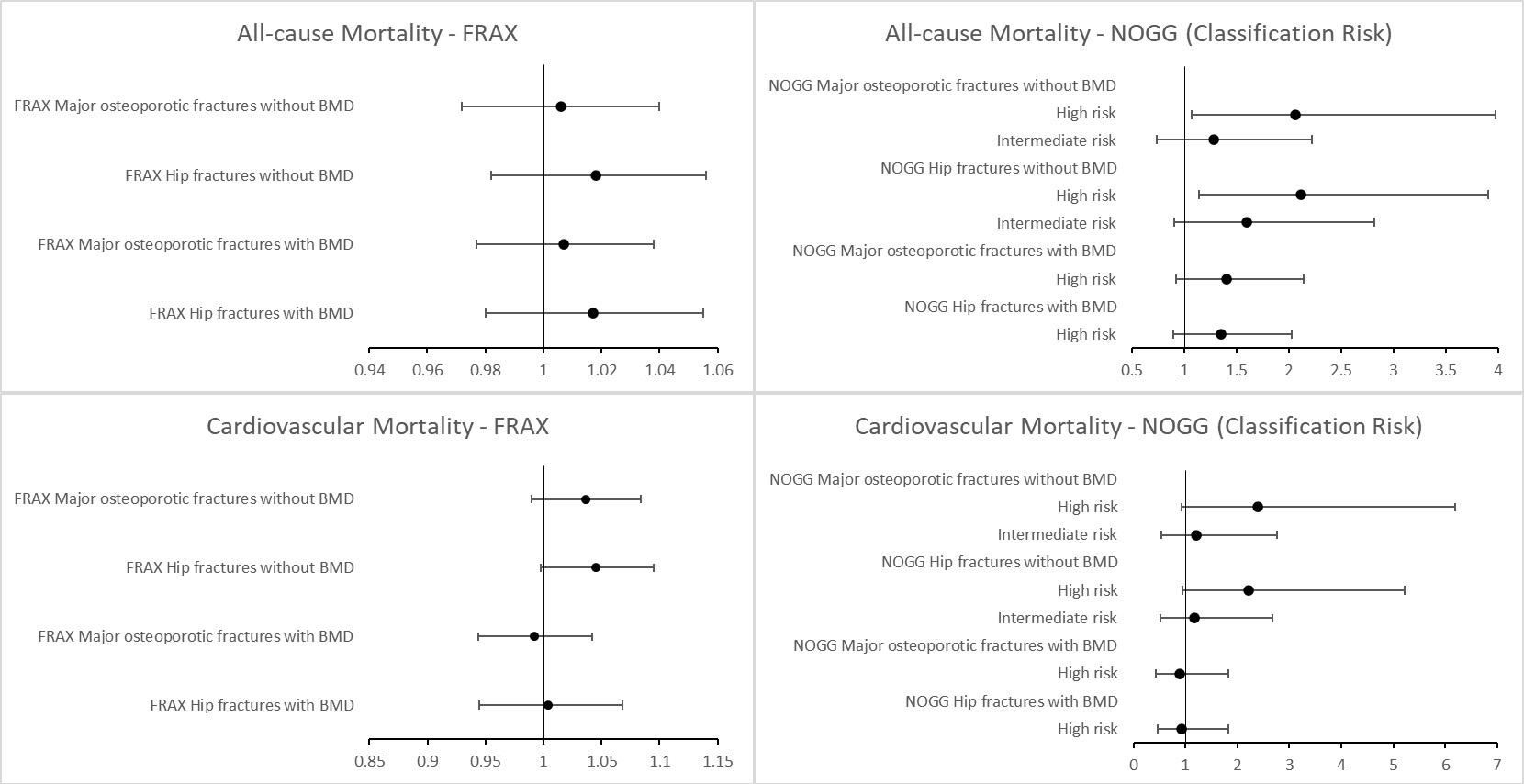Session Information
Date: Monday, November 18, 2024
Title: Osteoporosis & Metabolic Bone Disease – Basic & Clinical Science Poster
Session Type: Poster Session C
Session Time: 10:30AM-12:30PM
Background/Purpose: The World Health Organization Fracture Risk Assessment Tool (FRAX®) was developed to estimate the 10-year absolute probability of osteoporotic fractures among the general population. In Brazil, the National Osteoporosis Guideline Group (NOGG) methodology is used to categorize absolute fracture risk obtained from FRAX into low, intermediate, and high risk. Although osteoporotic fracture and low bone mass are risk factors for death, the association between FRAX® and mortality is unknown. Therefore, this population-based prospective cohort study was conducted to evaluate the predictive ability of the FRAX® for all-cause and cardiovascular deaths in Brazilian community-dwelling elderlies.
Methods: A total of 835 older adults (513 women; 322 men), aged over 65 years, from a Brazilian population-based prospective cohort, were included in this analysis. FRAX probability and NOGG risk stratification were calculated for all subjects at baseline. The Cox proportional hazards model was employed to calculate hazard ratios and 95% confidence intervals. The backward likelihood ratio with stepwise selection method was utilized to identify the variables in the final models (entry: p< 0.05; removal: p >0.10) for all-cause and cardiovascular (CV) mortality. Kaplan-Meier curves for survival were generated, and comparisons were conducted using log-rank tests.
Results: Throughout the mean follow-up period of 4.06±1.07 years, 129 (15.4%) deaths occurred, comprising 66 women and 63 men, with 56 (43.4%) attributed to cardiovascular (CV) causes. The mean FRAX® scores for major osteoporotic fracture were 10.0±8.6% and 7.4±5.0% in the deceased and surviving groups, respectively. Univariate analyses revealed that the deceased group exhibited lower hip bone mineral density (BMD), along with higher FRAX values and risk classifications (Fig. 1). Following adjustments for other significant mortality risk factors within this population (including age, sex, recurrent falls, physical activity score, diabetes mellitus, prior cardiovascular events, hip BMD, and intact parathyroid hormone levels), multivariate Cox regression analyses identified the high-risk category for major osteoporotic fracture (HR 2.06, 95% CI 1.07-3.97, P=0.03) and hip fracture (HR 2.11, 95% CI 1.14-3.90, P=0.017) as independent predictors of all-cause mortality (Fig. 2 and Fig. 3). Due to the limited number of CV deaths, the multivariate analysis for CV mortality indicated only a trend for high-risk categories for major osteoporotic fracture (HR 2.21, 95% CI 0.94-5.22, P=0.07) and hip fracture (HR 2.38, 95% CI 0.92-6.18), as well as FRAX absolute probability for hip fracture (HR 1.04, 95% CI 0.998-1.09, p=0.063, per each 1%-increase) (Fig. 2).
Conclusion: Among the elderly Brazilian population residing in the community, the FRAX® tool appears to be useful in predicting mortality risk.
To cite this abstract in AMA style:
Freitas T, Olalla L, Machado L, Figueiredo C, Takayama L, Caparbo V, Oliveira R, Domiciano D, Pereira R. Fracture Risk Assessment Tool (FRAX®) Scores Predict Mortality in Community-Dwelling Elderlies [abstract]. Arthritis Rheumatol. 2024; 76 (suppl 9). https://acrabstracts.org/abstract/fracture-risk-assessment-tool-frax-scores-predict-mortality-in-community-dwelling-elderlies/. Accessed .« Back to ACR Convergence 2024
ACR Meeting Abstracts - https://acrabstracts.org/abstract/fracture-risk-assessment-tool-frax-scores-predict-mortality-in-community-dwelling-elderlies/



